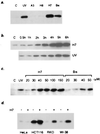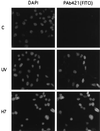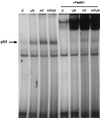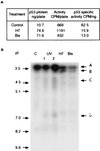Stabilization and activation of p53 are regulated independently by different phosphorylation events
- PMID: 9482877
- PMCID: PMC19322
- DOI: 10.1073/pnas.95.5.2284
Stabilization and activation of p53 are regulated independently by different phosphorylation events
Abstract
Treatment of mouse or human cells with the protein kinase C (PKC) inhibitors H7 or bisindolylmaleimide I induced an increase in the lifetime of p53, leading to its accumulation. In inhibitor-treated cells, p53 translocated to the nuclei and bound to DNA but was not competent to induce transcription. However, transactivation could be induced by subsequent DNA damage. Phorbol ester, a potent activator of PKC, significantly inhibited the accumulation of p53 after DNA damage. Therefore, constitutive PKC-dependent phosphorylation of p53 itself, or of a protein that interacts with p53, is required for the rapid degradation of p53 in untreated cells. Furthermore, an increase in the lifetime of p53 is not accompanied necessarily by its activation. Treatment with the PKC inhibitors decreased the overall level of p53 phosphorylation but led to the appearance of a phosphopeptide not seen in tryptic digests of p53 from untreated cells. Therefore, the lifetime and activities of p53 are likely to be regulated by distinct alterations of the phosphorylation pattern of p53, probably caused by the actions of different kinases.
Figures







References
-
- Yin Y, Tainsky M A, Bischoff F Z, Strong L C, Wahl G M. Cell. 1992;70:937–948. - PubMed
-
- Hollstein M, Sidransky D, Vogelstein B, Harris C C. Science. 1991;253:49–53. - PubMed
-
- Kastan M B, Onyekwere O, Sidransky D, Vogelstein B, Craig R W. Cancer Res. 1991;51:6304–6311. - PubMed
-
- Fritsche M, Haessler C, Brandner G. Oncogene. 1993;8:307–318. - PubMed
Publication types
MeSH terms
Substances
Grants and funding
LinkOut - more resources
Full Text Sources
Research Materials
Miscellaneous

